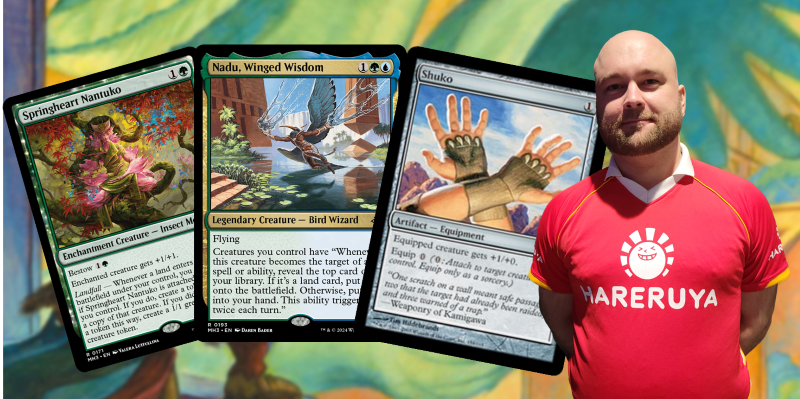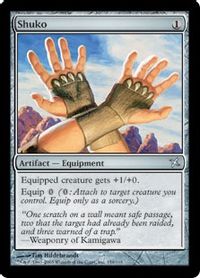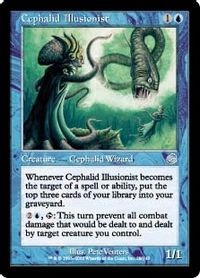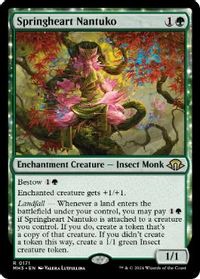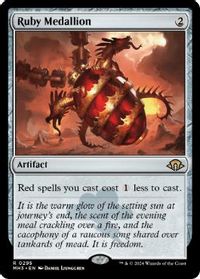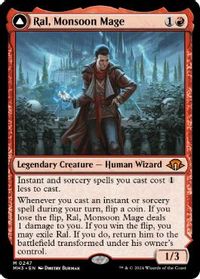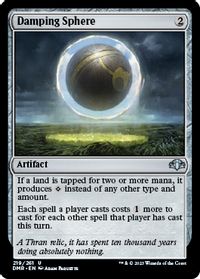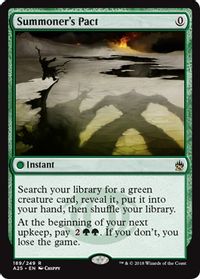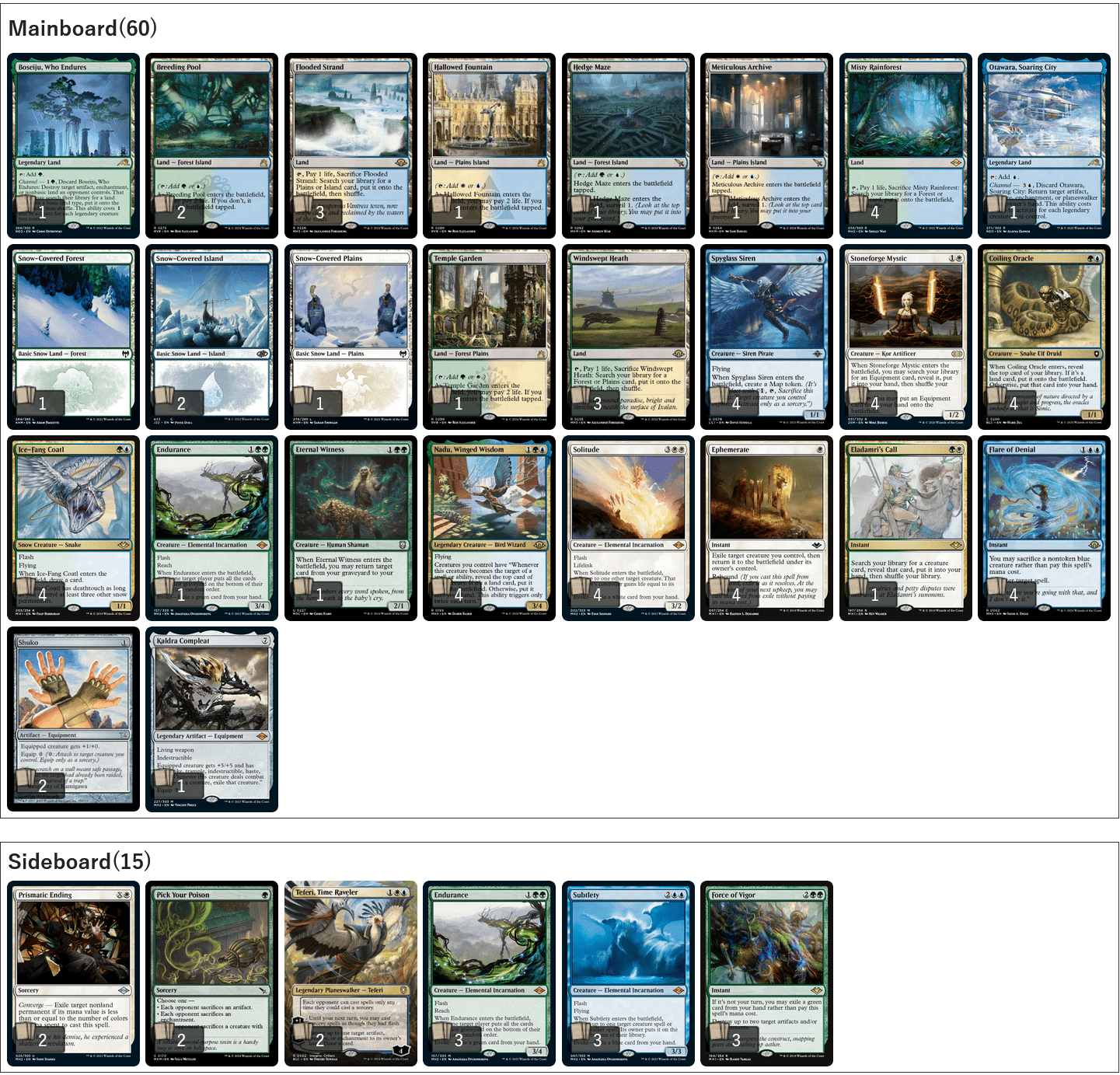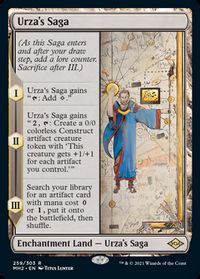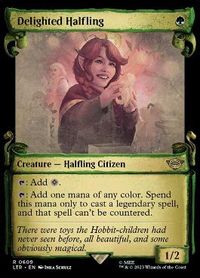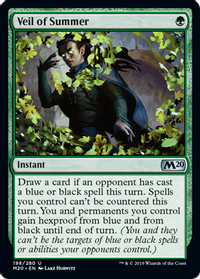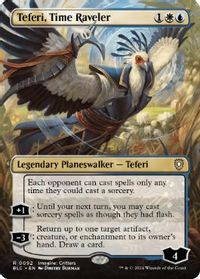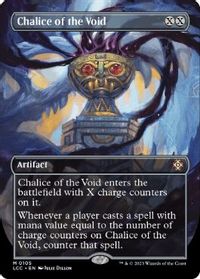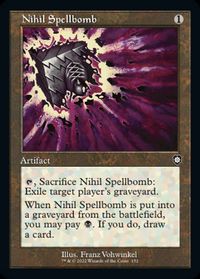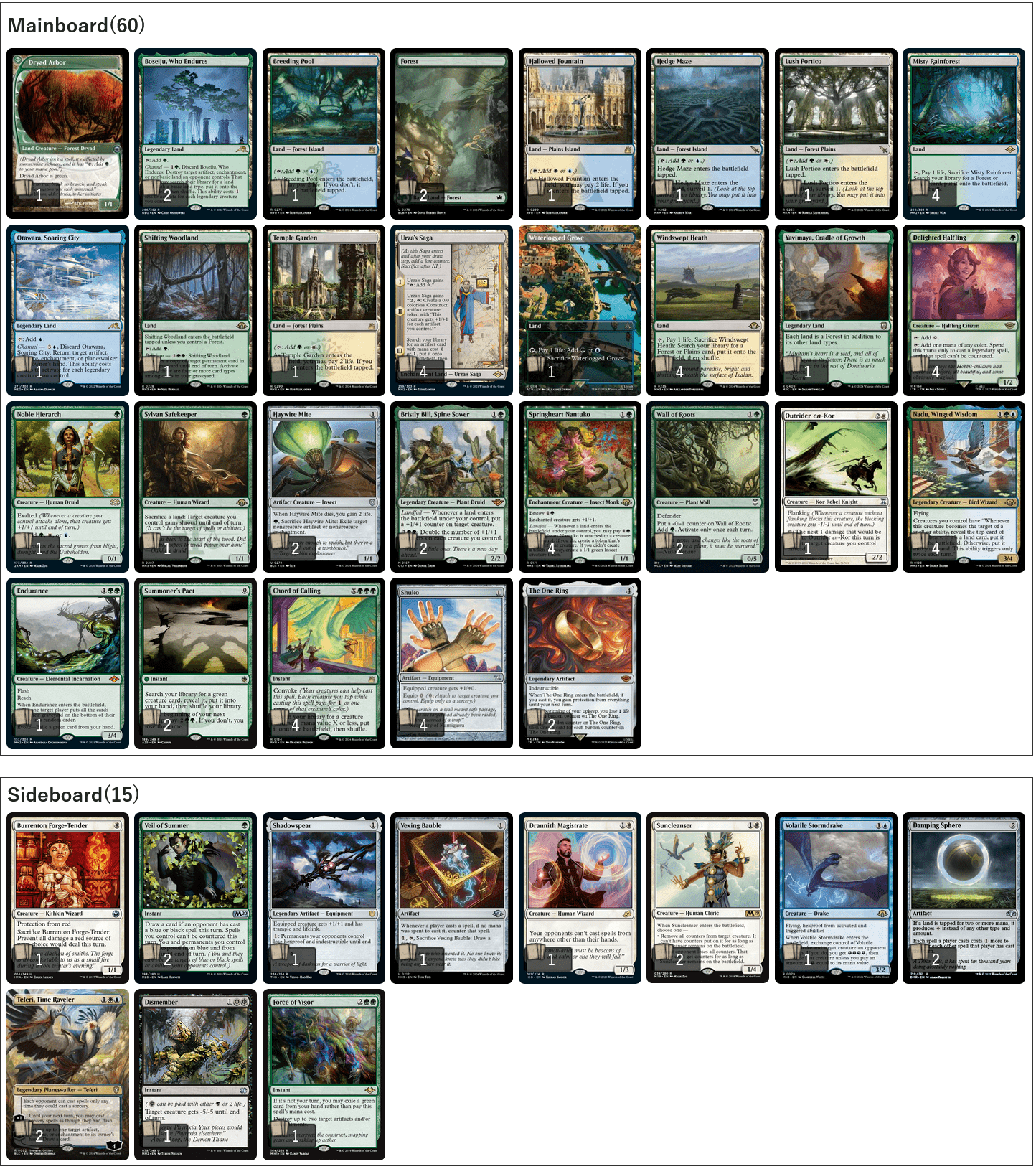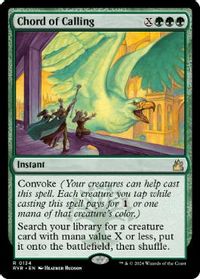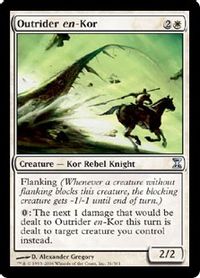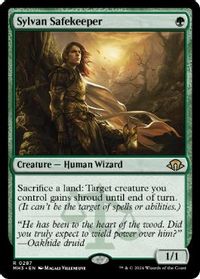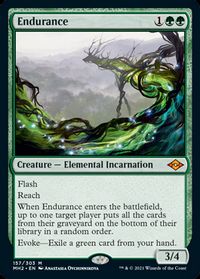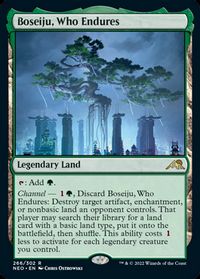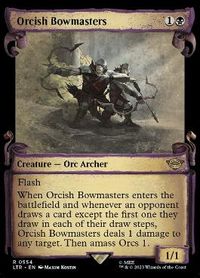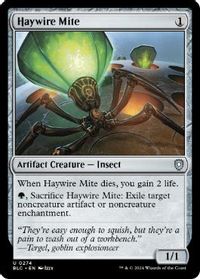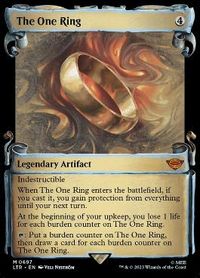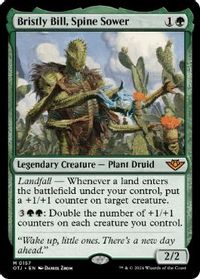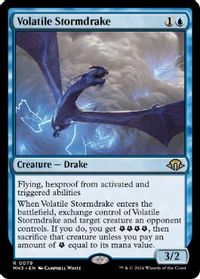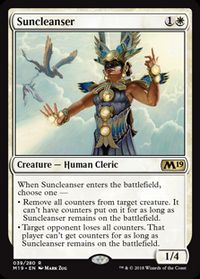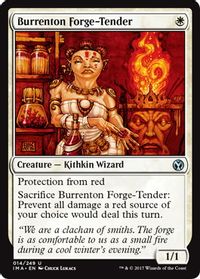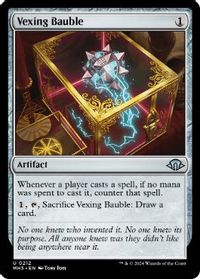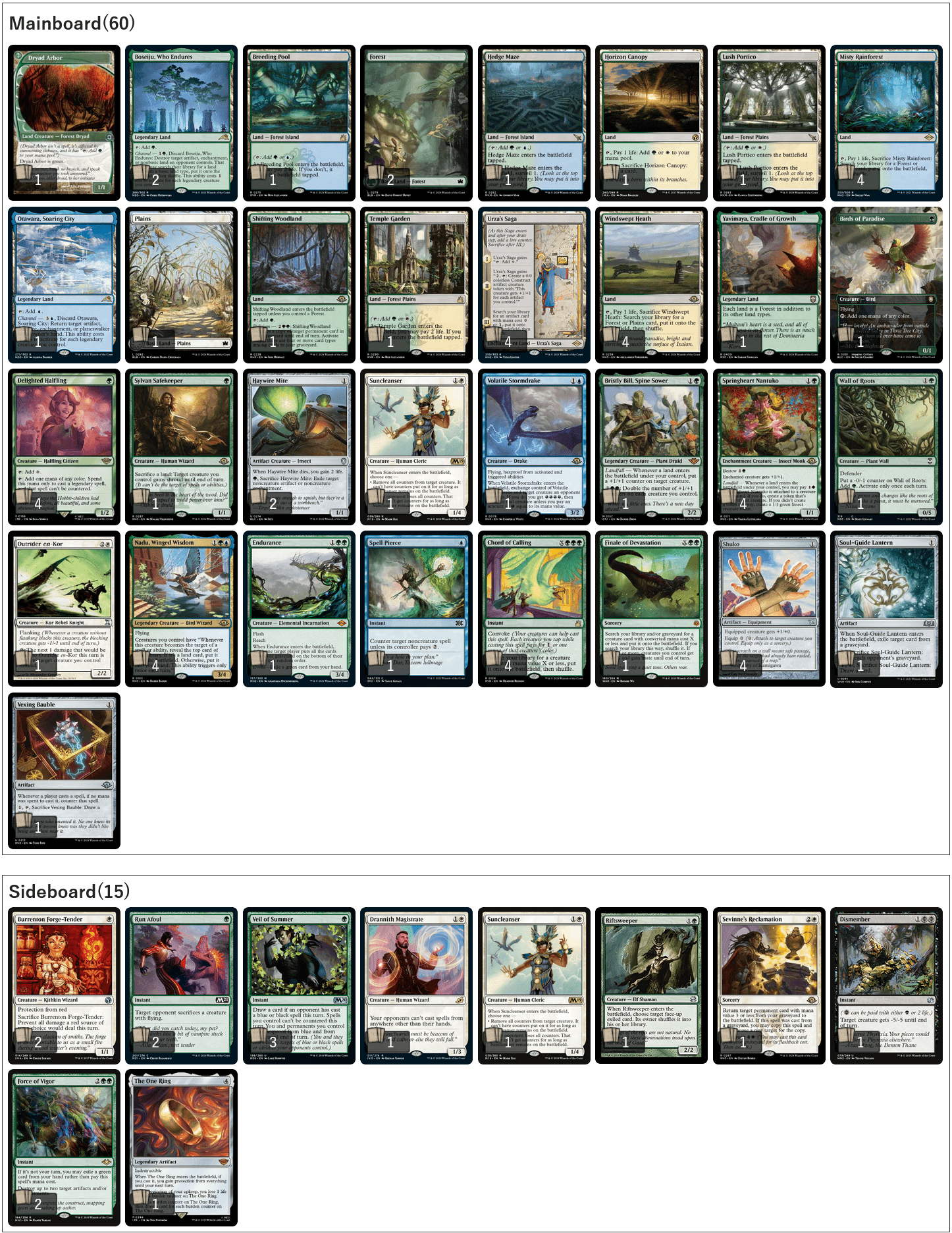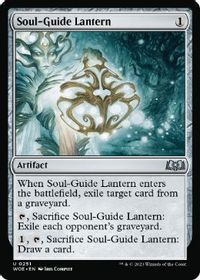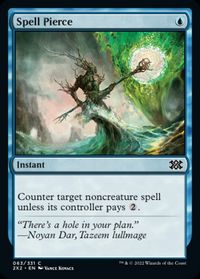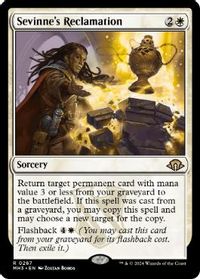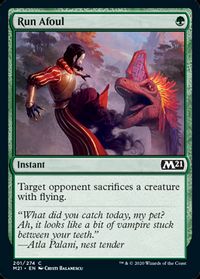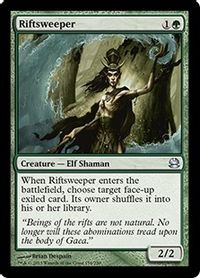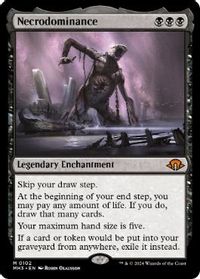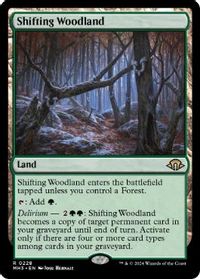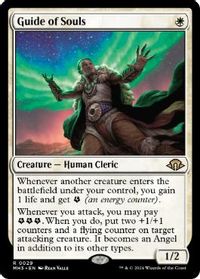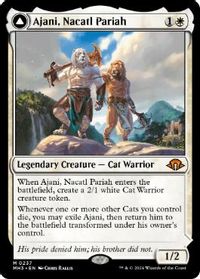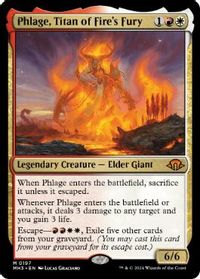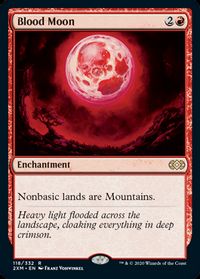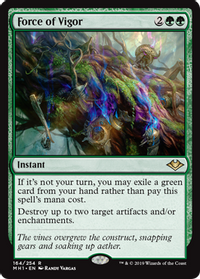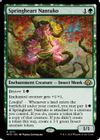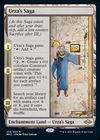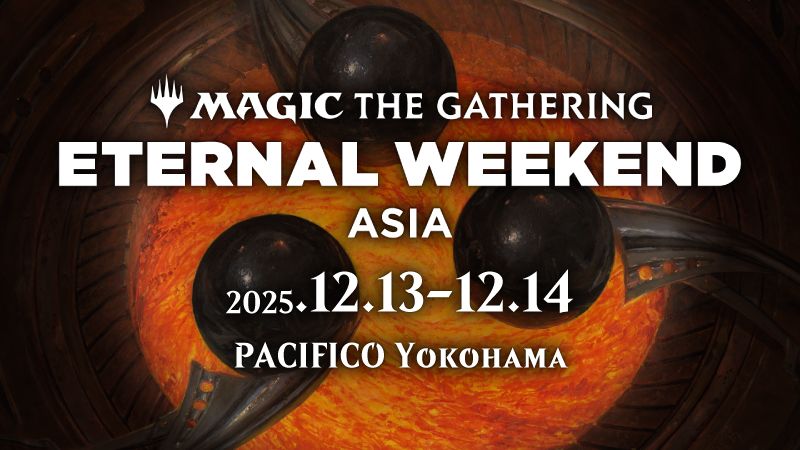Introduction
At the end of June, Pro Tour Modern Horizons 3 was held in Amsterdam, and the deck of the tournament was undeniably the combo deck centered around 《Nadu, Winged Wisdom》 and 《Shuko》. The Top 8 of the tournament consisted of 5 copies of the Nadu deck, and in the playoffs on Sunday those five players only lost to each other. The eventual winner was reigning Player of the Year Simon Nielsen, whom I’m happy to call a teammate.
🏆Congratulations to Simon Nielsen, winner of Pro Tour Modern Horizons 3!🏆
— PlayMTG (@PlayMTG) June 30, 2024
After two incredible years – including winning Player of the Year and making the Top 8 in five out of six events – he finally secured his first ever Pro Tour victory.
Congratulations again, Simon! pic.twitter.com/etQyotNe8I
The Nadu deck was not exactly a secret coming into the tournament, and we (Team Handshake) were not the only team to play it. It rightfully ended up being the most played deck of the tournament, and in a rare feat the most popular deck was also the most successful one.
Despite us not being the only ones to play the deck, I do think our list was better than the others. This article will give an overview of why the deck is so good, how we ended up building the deck as we did, how I would recommend building it going forward, and how to navigate your way through a hostile metagame.
The Force Awakens
When 《Nadu, Winged Wisdom》 was previewed for Modern Horizons 3, it didn’t take long for the hive mind to recognize its potential with cheap ways of targeting your own creatures.
HERE IS MY MH3 PREVIEW CARD(s)!!
— d00mwake (@d00mwake) May 24, 2024
Nadu looks like a potential sweet build around, and the Buried Alive reprint certainly has some applications.
Thank you to WOTC for sending these #freepreview cards! pic.twitter.com/nIsxspS02u
Pairing it up with 《Shuko》 was an obvious thing to do, since the artifact has already been used for a very similar purpose in Legacy alongside 《Cephalid Illusionist》. Before the set was even released, our team started working on building different versions of the deck.
Another key card from the new set was 《Springheart Nantuko》, which makes sure that you don’t run out of new creatures to target with 《Shuko》, resulting in an endless stream of triggers from Nadu’s ability.
For a combo deck, I think the three most important dimensions of deckbuilding are Speed, Consistency and Resiliency. When you start working on a new combo deck and trying to figure out whether your deck is a dud or a format-breaker, you should figure out how to maximize those three factors and how well the deck scores on those metrics.
As an example, if you look at the new Ruby Storm deck, it’s very clear that it scores extremely well on speed. It can kill on turn 2 with hands that contain two Ritual effects, a way to make them cheaper (《Ruby Medallion》; 《Ral, Monsoon Mage》), and a way to access more cards (《Wrenn’s Resolve》, 《Reckless Impulse》).
However, the deck had an abysmal win rate at the Pro Tour despite being played by some of the best players to ever play the game, such as Kai Budde, Jon Finkel and Luis Scott-Vargas.
Why? Because it wasn’t resilient.
There were a lot of 《Drannith Magistrate》 and other hate cards registered at the tournament, and Ruby Storm simply wasn’t robust enough to fight its way through it all.
While working on the Nadu deck, some of our versions were all-in combo decks focusing mostly on speed. 《Summoner’s Pact》, for example, is a card that’s great for speed and consistency, but pretty bad for resilience. It’s a cheap tutor for one of your combo pieces so it helps you go off on turn 3, but it plays quite poorly against interaction – if they can answer the Nadu, you’re essentially skipping your following turn due to the Pact trigger.
Other versions we built were more midrangey and fair, focusing on resiliency, such as this:
This version was significantly slower on average, but it didn’t care much about hate.
Somewhat surprisingly, we found that even the faster versions scored well in resiliency. 《Urza’s Saga》 in particular was a strong card in all three aspects: not only did it find your 《Shuko》 for turn 3 while giving you mana to cast your 《Nadu, Winged Wisdom》, it also acted as an alternate win condition, making you more resilient. Pressure from the Construct tokens made it harder for the opponent to answer your combo.
In addition to the 《Urza’s Saga》, Nadu also has access to other great tools against interaction: 《Delighted Halfling》, 《Veil of Summer》 and 《Teferi, Time Raveler》 are excellent against counterspells, whereas Nadu itself is naturally good against removal spells as you get to draw a card if they try to kill it with spot removal. 《The One Ring》 can also outpower any opponent trying to kill your creatures.
Not only is the deck capable of outracing almost any other deck, but if you really want to beat it, it’s not even clear what you should do. If you want to beat Storm, you play 《Drannith Magistrate》, and if you want to beat Living End, you can play 《Chalice of the Void》, 《Flusterstorm》 and 《Nihil Spellbomb》. But against Nadu there is no simple answer.
The Clone Wars
In the end, out of the many ways to build the deck we settled on was this:
Core Pieces
In addition to the cards mentioned above, some of the core pieces of the deck are:
《Chord of Calling》
An instant speed tutor that can basically get any of the combo pieces. It makes you more consistent, and helps you push through the combo against control players by bottlenecking their mana.
《Outrider en-Kor》
Tutor target for 《Chord of Calling》 that lets you go off at instant speed.
《Sylvan Safekeeper》
《Sylvan Safekeeper》 can get your engine going by targeting your creatures, protects your 《Nadu, Winged Wisdom》, and enables loops with 《Endurance》.
《Endurance》
《Endurance》 enables all kinds of loops when you bestow a 《Springheart Nantuko》 on it, starting from generating infinite mana with the 《Sylvan Safekeeper》.
Those cards were included in basically all of the versions played at the tournament.
Speaking of the loops, the most basic thing to do after bestowing a 《Springheart Nantuko》 on 《Endurance》 is making a copy of the 《Endurance》, then sacrificing your lands to 《Sylvan Safekeeper》 in response to the shuffle trigger, and then putting them back into play and doing it all again. Triggers from the 《Springheart Nantuko》 give you infinite creatures, and if you float mana before sacrificing the lands, you also get infinite mana.
From that point on you can do other things too, like bestow a 《Springheart Nantuko》 on something else to generate unlimited copies of other creatures (e.g. 《Haywire Mite》), or use 《Waterlogged Grove》, 《Boseiju, Who Endures》 and 《Otawara, Soaring City》 to get an unlimited amount of activations of the channel lands. The Channel land loops in particular get very convoluted, and honestly, they don’t really matter all that much, so I’m not going to go too deeply into them.
Alternative
《Finale of Devastation》
Instead, I recommend doing what Jean-Emmanuel Depraz and the other French players did: play a 1-of copy of 《Finale of Devastation》. This card makes it trivially easy to actually kill the opponent on the same turn you go off, letting you avoid all the complications of having to pass the turn before actually winning the game. 《Finale of Devastation》 is a totally serviceable card otherwise as well, as it’s a fairly priced tutor for your combo pieces.
《Orcish Bowmasters》
Another acceptable alternative is playing some number of 《Orcish Bowmasters》. For example, Daniel Goetschel’s list from the top 8 of the tournament played 4 copies of the card. Bestowing a 《Springheart Nantuko》 on 《Orcish Bowmasters》 can let you make an unlimited number of them and thus kill your opponent with the 1-damage triggers.
However, I don’t think it’s a very good card otherwise in the current metagame, and having to support Black cards makes your mana base considerably worse.
《Thassa’s Oracle》
The last common alternative for actually winning the game is 《Thassa’s Oracle》, but that one I’m strongly opposed to. 《Thassa’s Oracle》 is quite embarrassing when drawn and cast naturally, and not at all necessary.
Even worse than playing the 《Thassa’s Oracle》 alone is playing the Oracle in a list that also contains the 《Finale of Devastation》 or the 《Orcish Bowmasters》. Daniel Goetschel’s list from the top 8 included both the 《Orcish Bowmasters》 and the 《Thassa’s Oracle》, and at that point the Oracle is just completely redundant. That said, the core of the deck is so strong that you can clearly afford to play a dead card in your main deck and still top 8 a PT.
Flex Slots
For the flex slots of the deck our team chose to play the following:
4 《Delighted Halfling》 / 2 《Wall of Roots》
Pretty much every team played with some mana accelerants, and we prioritized the 《Delighted Halfling》 for its strength against counterspells and 《Wall of Roots》 for its synergy with 《Chord of Calling》. We avoided 《Arboreal Grazer》, which we felt made the deck worse at mulliganing and grindy games.
2 《Haywire Mite》
The first copy is an easy inclusion as a tutor target for 《Urza’s Saga》, but we were so impressed with it that we wanted a second copy as well. In particular, it’s good against the mirror, and can even let you win on the draw in a matchup that is usually just a pure race. Almost every deck has good targets for the 《Haywire Mite》, ranging from 《The One Ring》 to 《Ruby Medallion》 and 《Necrodominance》.
2 《The One Ring》
A powerful tool against the control decks, especially in conjunction with 《Delighted Halfling》.
2 《Bristly Bill, Spine Sower》
A tutor target for 《Summoner’s Pact》 that can get your combo started, and also a decent backup plan, especially in the postboard games. During our testing process the 《Bristly Bill, Spine Sower》 were quite impressive and won a lot of fair games after the opponent had to spend their resources on preventing the combo.
《Volatile Stormdrake》
Both Jason Ye and Sam Pardee had a main deck copy of the 《Volatile Stormdrake》 in their top 8 lists, and honestly we were a bit jealous of them. We did have the card in the sideboard and we were considering playing it in the main deck too, but didn’t think there would be quite enough mirror matches to warrant its inclusion.
However, it’s definitely a powerful tool against other Nadu decks and in retrospect I wish I had moved it to the main deck too.
2 《Summoner’s Pact》 / 0 《Malevolent Rumble》
We expected a metagame where speed was important, so we played 2 copies of the 《Summoner’s Pact》 to make the fast kills more consistent. However, if you expect a metagame with more interactive decks like Jeskai Control, then I would recommend playing the 《Malevolent Rumble》 instead.
Another one of the Nadu deck’s strengths is that it has access to a wide array of powerful sideboard tools. Unlike many other combo decks, Nadu actually becomes better postboard in a lot of matchups. Through 《Chord of Calling》 and 《Urza’s Saga》 it can leverage many of the sideboard slots by accessing them more frequently than is usually possible, and those tutor targets are often extremely impactful in the matchups where they’re good.
Sideboard
Some highlights from the sideboard:
《Suncleanser》
A powerful hate card against the Boros Energy decks that have trouble getting rid of it, and a countermeasure against 《Wrath of the Skies》, which is one of the best cards against the deck. Note that you can 《Chord of Calling》 for the 《Suncleanser》 in response to a 《Wrath of the Skies》 to severely reduce its effectiveness (although they can still kill tokens and 《Urza’s Saga》).
《Teferi, Time Raveler》+《Veil of Summer》
A truly powerful duo against almost every deck that tries to interact with you.
《Burrenton Forge-Tender》
A good stand-alone card against Red decks, and particularly useful as a tutor target for 《Chord of Calling》 to be able to combo through a 《Harsh Mentor》. Making copies of it with the 《Springheart Nantuko》 is also fun.
《Drannith Magistrate》
Simply the best card in the format against Ruby Storm. Particularly good in this deck because you can protect it with 《Sylvan Safekeeper》. Assembling those two cards is close to a hard lock against Storm.
《Vexing Bauble》
An awesome tutor target against decks with 0 mana counterspells, evoke elementals and 《Soul Spike》.
Latest List
While we were overall happy with the decklist for the Pro Tour, I would make some changes to it going forward. This is the latest list I’ve been playing with:
With Storm being on the downswing after its horrendous results at the PT it’s a little bit less important to be fast, and thus I cut the 《Summoner’s Pact》 and replaced them with some powerful one-ofs. 《Volatile Stormdrake》 is there to improve the mirror match, 《Vexing Bauble》 is great against Mono-Black and Jeskai, 《Soul-Guide Lantern》 helps grind through 《Phlage, Titan of Fire’s Fury》 and 《Goryo’s Vengeance》, and 《Suncleanser》 can steal games against 《Wrath of the Skies》.
《Spell Pierce》 is a card I really like as a one-of and with closed decklists you can really catch people off guard with it. I also added the 《Finale of Devastation》 that I talked about earlier. It’s particularly important in online play, as you can’t really execute the loops there without timing out.
To the sideboard I added a 《Sevinne’s Reclamation》 for the grindy matchups, and a couple of 《Run Afoul》 for the mirror. There’s also a 《Riftsweeper》 now, as Tron lists have started packing a lot of 《The Stone Brain》, and Mono-Black lists sometimes play 《Necromentia》 and 《Profane Tutor》.
《The One Ring》 is also not that great in the current metagame, so I’ve relegated it to the sideboard – it’s still great against control, but a bit too slow against most other decks.
The Empire Strikes Back
As the Nadu deck has become more popular, opponents have also become more and more prepared for it, so it’s important to know how they are trying to beat you and what you can do about it. There’s a lot of variance in decklists nowadays even within archetypes, so it’s not very practical to give a precise sideboard guide this time.
Instead, I’ll give you some general pointers on what’s important in each matchup and what you should be on the lookout for.
Mono-Black Necro
I’ve heard multiple people say that this is supposed to be a bad matchup for Nadu, but I’m not sold on that being the case. The results from the Pro Tour also indicate towards Nadu being the favorite in the matchup.
First of all, if you can stop them from drawing cards with 《Necrodominance》 itself, their deck becomes a lot worse. 《Boseiju, Who Endures》 is premium here, as it’s an instant speed answer to the enchantment that they can’t even take away with their discard spells. 《The One Ring》 can be annoying too if it sticks, but it’s a lot slower and significantly easier to stop with 《Haywire Mite》.
《Vexing Bauble》 is the MVP here, especially if you draw it in your opening hand on the play, as then it can stop a turn 1 《Grief》 scam as well. Taking away their 《Soul Spike》 makes their card draw a lot less reliable, and the 《Vexing Bauble》 also shuts down any anti-Nadu cards that they might play, such as 《Force of Despair》 and 《Flare of Malice》.
《Veil of Summer》 is obviously a great sideboard card here, and 《Sevinne’s Reclamation》 is a nice new tool that is resilient to discard spells. I would also consider bringing in at least one 《Force of Vigor》 for 《Necrodominance》, at least on the draw.
In the post-board games it’s usually quite hard to go off with the combo, but the deck is definitely capable of winning games by attacking too. Even if you can’t quite kill them, reducing their life total by attacking is still important and useful as it makes their 《Necrodominance》 and 《The One Ring》 weaker.
Because your plan is less about the combo, the games tend to go long, and they usually don’t have any answers to artifacts or 《Urza’s Saga》, you can board out 1-2 《Shuko》. Boarding out important combo pieces can feel unintuitive especially against a deck with discard spells, but you can usually find one of those when you need one – it’s usually not the angle they are trying to attack you from, and drawing multiple copies is bad.
Jeskai Control
Many of the one-ofs really shine here and make the games very dynamic. Again, 《Suncleanser》 is great against 《Wrath of the Skies》, 《Vexing Bauble》 against 《Force of Negation》 and 《Subtlety》, 《Soul-Guide Lantern》 against 《Phlage, Titan of Fire’s Fury》, and 《Haywire Mite》 against 《The One Ring》. Sometimes you can even steal a 《Phlage, Titan of Fire’s Fury》 with 《Volatile Stormdrake》! 《Spell Pierce》 can also be devastating.
《Urza’s Saga》 is both a blessing and a curse. It’s an uncounterable way to put on pressure and force them to react, but it is also extremely weak to 《Wrath of the Skies》, so I tend to board one or two copies out. I like 《Shuko》 a lot more than the 《Urza’s Saga》, because you can hold it in your hand until you’re ready to go off, and thus get to avoid the overextension issues and 《Prismatic Ending》. It’s cheap enough that you can almost always sneak it into play on the combo turn, especially when the games tend to go long.
This is another matchup where I would bring in both 《Veil of Summer》 and 《Sevinne’s Reclamation》. I’ve found 《Veil of Summer》 to work particularly well in conjunction with 《Chord of Calling》. A common play pattern is for the opponent to cast a 《Wrath of the Skies》 with a 《Counterspell》 up, which you can punish by 《Chord of Calling》 for a 《Suncleanser》 and Veiling their 《Counterspell》. Whenever this happens it’s such a massive swing that it usually ends the game on the spot.
《Shifting Woodland》 is great in this matchup, as it can act as a 《Nadu, Winged Wisdom》 that they can’t counter. During the testing process for the Pro Tour I was often playing the matchup from the control side, and died a bunch of times to the 《Shifting Woodland》 with multiple counterspells in hand.
Boros Energy
While the Boros Energy deck plays a lot of powerful cards from Modern Horizons 3, it’s neither fast enough to race Nadu nor particularly good at disrupting it. 《Guide of Souls》 is probably their best card, as it can help them put on a fast clock, but the core issue for them is the lack of relevant interaction. In game 1 their interaction is mostly spot removal, so 《Sylvan Safekeeper》 is very effective at protecting your combo.
Against the straight Red-White builds you should be cautious of 《Blood Moon》 and probably board out some of your 《Urza’s Saga》, especially since the 《Urza’s Saga》 is also vulnerable to 《Wear/Tear》. Speaking of the split card, you should try to avoid having an artifact and an enchantment in play at the same time, especially if the opponent is keeping up 3 mana on your turn.
One of their most common hate cards is 《Harsh Mentor》, which you can counteract with a 《Burrenton Forge-Tender》, a 《Volatile Stormdrake》 or a 《Dismember》. Against the 《Harsh Mentor》 you can also go off at instant speed on the opponent’s turn. On their turn your triggers resolve before theirs, meaning that you can activate 《Outrider en-Kor》 to get a Nadu trigger, and then before their 《Harsh Mentor》 trigger resolves you can activate the 《Outrider en-Kor》 again to get another Nadu trigger, and so on.
Eventually you want to find a 《Chord of Calling》 to tutor up a 《Burrenton Forge-Tender》 so that you can activate it on the 《Harsh Mentor》 while all of their triggers are still on the stack. After the 《Burrenton Forge-Tender》 activation you can finally let all of their triggers resolve for no effect. Note that this plan often requires having a 《Springheart Nantuko》 in play beforehand so that you don’t run out of things to target.
This same play pattern is also relevant against other Red decks that play 《Harsh Mentor》, like Burn and Prowess.
Mirror Match
Game 1 is almost exclusively about racing, and you should be mulliganing aggressively towards hands that can kill on turn 3. You should also be aware that on the draw even a guaranteed turn 3 kill is likely not enough, so the cards you’re hoping to see the most are actually 《Haywire Mite》, 《Boseiju, Who Endures》 and 《Volatile Stormdrake》. Annoyingly, if you’re on the draw you probably won’t have time to tutor up the 《Volatile Stormdrake》, but if you draw it naturally you can sometimes steal a Nadu or some other critical creature with it and win that way.
Postboard games are more interactive. 《Force of Vigor》 and 《Run Afoul》 are both premium sideboard cards here as they can help you win on the draw. The presence of these and other interactive cards means that slower and more resilient hands become better than they are in the pre-board games. If your opponent is also playing 《Run Afoul》, 《Birds of Paradise》 becomes important as a way to protect your 《Nadu, Winged Wisdom》.
This is another matchup where you often want to hold back 《Shuko》 in your hand even if it means not spending your mana efficiently, as you want to avoid getting blown out by a 《Force of Vigor》 – let them 《Force of Vigor》 a 《Urza’s Saga》 or a 《Shuko》, but not two things!
Conclusion
The Nadu deck is easily the most powerful deck currently available in Modern. The combination of speed, consistency and resiliency is hard to match, and I highly recommend playing it as long as it’s legal, although I must admit that there’s a good chance that it won’t stay that way for long.
Your opponents will be prepared with hate cards, but they’re all very beatable, and figuring out how to power through the hate is a lot of fun (at least in my opinion). Now that everybody knows what’s up and they’re trying their best to beat you, the games are more interactive and challenging, and winning feels more rewarding.
Happy hunting!
Matti Kuisma (X)
Related Articles
- 2024/07/04
- Tales from the Finnish CubeCon
- Matti Kuisma
- 2024/06/11
- Fundamentals of Sideboarding in Limited
- Matti Kuisma


